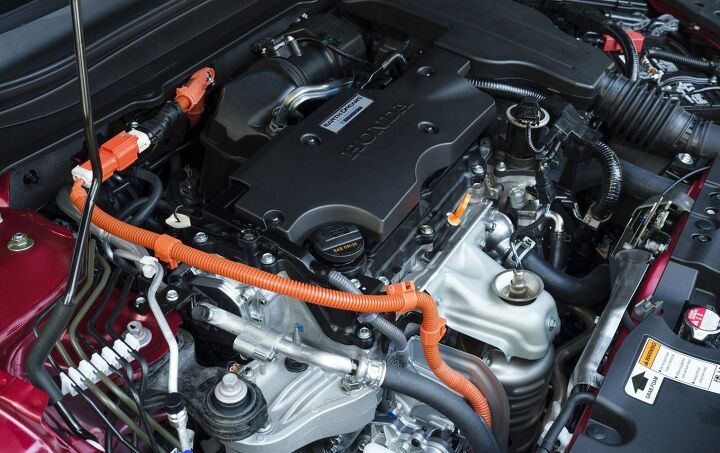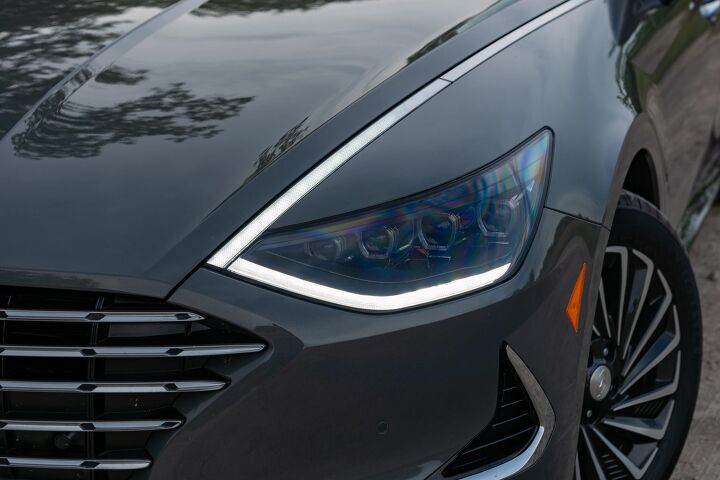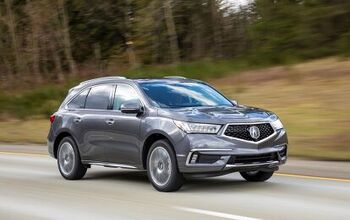Honda Accord Vs Hyundai Sonata: Which Sedan is Right for You?

When the market is dominated by SUV offerings, the humble family sedan is quickly becoming an overlooked choice. Often offering just as much utility as their taller cousins, the mid-size sedan is a sensible way to comfortably transport a gaggle of people and things.
The Honda Accord stands as the stalwart choice in the segment, setting a target for other manufacturers to hit up to. Its combination of performance and utility makes it a no-brainer consideration.
Get a Quote on a New Honda Accord or Hyundai SonataHyundai’s Sonata offers a flashy and well-equipped option, and competes head-on with its own hybrid drivetrains.
Has the up-and-comer from Hyundai finally reached the same level of refinement as the Honda Accord? We dig deep into the features and specifications of the Honda Accord vs Hyundai Sonata.
Cabin Space

Honda Accord: The Accord comes in at 39.5 inches (1,004 mm) of headroom without a moonroof, and 37.5 inches (953 mm) with one. Rear headroom is measured at 37.3 inches (948 mm) and 37.2 inches (944 mm), respectively. There is 42.3 inches (1,075 mm) of legroom for those in the front, and 40.4 inches (1,026 mm) for anyone riding in the rear. Shoulder room is 58.3 inches (1,481 mm) in the front and 56.5 inches (1,436 mm) in the rear, with 55.3 inches (1,405 mm) of front hip room and 55.0 inches (1,398 mm) in the back.

Hyundai Sonata: All Sonatas will see 40 inches (1,016 mm) of headroom in the front. Gasoline-only models will have 38.4 inches (975 mm) of headroom in the back row, but Hybrid models lose a bit of height with 37.8 inches (960 mm). The front row is blessed with a luxurious 46.1 inches (1,171 mm) of legroom, but backseat tag-alongs will have to make do with just 34.8 inches (884 mm). There is 57.9 inches (1,471 mm) of shoulder room in the front and 56.1 inches (1,425 mm) in the rear. Front hip room is 54.6 inches (1,387 mm) with 54.4 inches (1,382 mm) in the back seats.
Bottom Line: With more headroom than the Accord, the Sonata is skewed towards providing more space to stretch out the legs in the front row. Back seat passengers will find more comfort in the Accord with much more legroom, and slightly more shoulder and hip room.
Honda Accord vs Hyundai Sonata: Powertrains

Honda Accord: The Accord lineup can be had with a choice of three engines. The smallest of the trio is a 1.5L turbo 4-cylinder, available on LX, Sport, and EX-L trims. Mated to a CVT, it’ll do 192 hp and 192 lb-ft of torque. A more powerful 2.0L turbo 4-cylinder is good for 252 hp and 273 lb-ft, with a 10-speed automatic sending power to the front wheels.
The sensible drivetrain choice is the Hybrid option, powered by a 2.0L 4-cylinder Atkinson Cycle engine with electric power as support. The companion E-CVT helps to put down the power, rated at 212 hp for the combination of internal combustion and electricity.

Hyundai Sonata: Unlike the Accord, Hyundai offers four different engine configurations. A 2.5L 4-cylinder unit is found in SE and SEL trims, rated for 191 hp and 181 lb-ft. of torque and attached to an 8-speed automatic. SEL Plus and Limited trims come with a smaller 1.6L 4-cylinder pushing 180 hp and 195 lb-ft. of torque, also with an 8-speed automatic. The N Line puts the urgency in your daily commute with a 2.5L turbocharged 4-cylinder, rated for 290 hp and 311 lb-ft., mated to an 8-speed automated dual clutch box.
The Hybrid varieties of the Sonata are powered by a 2.0L Atkinson Cycle 4-cylinder coupled with a 39 kW electric motor. A combined hybrid system figure of 192 hp is matched with a 6-speed automatic, driving the front wheels.
Bottom Line: The Sonata N Line with its 290 horses shines through as a beacon of performance, if that’s what you are looking for. Otherwise, Honda’s hybrid and 1.5L offerings may prove to be more fun than the Hyundai equivalent.
Fuel Economy

Honda Accord: 1.5L engines found on the LX and EX-L trims are rated at 30 MPG (7.8 L/100km) in the city, 38 MPG (6.2 L/100km) on the highway, and 33 MPG (7.1 L/100km) combined. Switch to the Sport trims and the numbers dip slightly to 29/35/32 MPG (8.1/6.7/7.4 L/100km). The quicker 2.0L engine will see 22/32/26 MPG (10.7/7.4/9.0 L/100km).
SEE ALSO: 2021 Honda Accord Hybrid Review: The Great All-RounderHybrid and EX-L Hybrid Accords are quoted for 48 MPG (4.9 L/100km) in the city and 47 MPG (5.0 L/100km) on the highway for 47 MPG (5.0 L/100km) combined. Sport Hybrid and Touring Hybrid trims are a tad less efficient, coming in at 44/41/43 MPG (5.3/5.7/5.5 L/100km).

Hyundai Sonata: The basic SE trim of the Sonata is rated for 28/38/32 MPG (8.4/6.2/7.4 L/100km) for city, highway, and combined. Curiously, it’s the only trim with the ISG start-stop function. The same engine without start-stop found in the SEL, SEL Plus, and Limited trims see a slightly lower rating of 27/37/31 MPG (8.7/6.4/7.6 L/100km) for city, highway, and combined. The fast family-hauler N Line with its 2.5L turbo engine gets 23 MPG (10.2 L/100km) in the city, 33 MPG (7.1 L/100km) on the highway, and 27 MPG (8.7 L/100km) combined.
The thrifty Blue Hybrid trim offers a staggering 50/54/52 MPG (4.7/4.4/4.5 L/100km) for city/highway/combined. You’ll get a reduced 45/51/47 MPG (5.2/4.6/5.0 L/100km) with the same drivetrain in the SEL Hybrid and Limited Hybrid versions.
Bottom Line: The Hybrid offerings from Hyundai trumps their Honda equivalents. The story is the same when comparing the sportier engines from either brand, but it’s the standard middle-of-the-road engines that sees Honda coming through with a slight edge in fuel economy numbers.
Styling

Honda Accord: With the exception of some very minor changes, the current generation of Accord has looked more or less the same since its 2018 introduction. A strong horizontal front end is just shy of being imposing, while the design language aft of the front fenders are subtle and fluid, capped off by a modified Hofmeister Kink detail at the rear windows and C-shaped tail lights.

Hyundai Sonata: Some may describe the Sonata as a hungry fish or an angry robot, or maybe an angry fish. Not many would accuse the Sonata as being plain and indistinct, however. The toast-shaped front grille and headlight accents leading into the side trim creates a ton of visual interest. Hyundai is also right on trend with taillights that span across the rear, rather than two discrete units.
Bottom Line: The Sonata may not appeal to everyone, but is sure to create some conversation. The Accord on the other hand is a safe bet as a modest but handsome approach to a midsize sedan.
Cargo and Towing

Honda Accord: With the rear seats upright, the Accord allows for 16.7 cubic feet (473 L) of things in the trunk. The Accord is not rated for towing.

Hyundai Sonata: Without folding down the rear seats, the Sonata will allow for 16 cubic feet (453 L) of cargo in the trunk. As with the Accord, the Sonata is not rated for towing.
Bottom Line: An easy victory, it’s hard to beat the Accord with its class-leading 16.7 cubic feet of trunk space.
Honda Accord vs Hyundai Sonata: Safety

Honda Accord: All Accords come standard with the Honda Sensing Technology suite of features, which includes Collision Mitigation, Adaptive Cruise Control, Lane Keeping, Forward Collision Warning, Lane Departure, and Traffic Sign Recognition. Higher trim levels add onto the available Driver-Assistive Technologies, which include Blind Spot Information with Cross Traffic Monitor, Low-Speed Braking Control, and a Heads-Up Display on the Touring trim.

Hyundai Sonata: Many of Hyundai’s safety features come standard on the Sonata, including Forward Collision-Avoidance with Pedestrian Detection, Lane Keeping Assist, Lane Following Assist, Driver Attention Warning, and Smart Cruise Control with Stop & Go. Blind-Spot Collision-Avoidance Assist and Rear Cross-Traffic Collision-Avoidance Assist is optional on the SE, but standard on all other trims. A Blind-Spot View Monitor is only available on the Limited trim, and the Highway Driving Assist feature is standard starting from the SEL Plus and up.
Bottom Line: Neither car is shy in safety features, and offers much of the same technology as similar price points. We can call this one a tie.
Tech and Features

Honda Accord: As standard, all Accords come equipped with Apple CarPlay/Android Auto, an 8-inch touchscreen infotainment system, and dual-zone automatic climate control. Wireless CarPlay and Android Auto, wireless phone charging, SiriusXM, and heated front seats are standard with the 2.0L engine on the Sport trim, the Hybrid Sport, EX-L, and Touring. Leather seats, seat memory, and a 450-watt audio system come with the EX-L and Touring trims, and opting for the Touring will get you ventilated seating in the front and heated rear seats, plus Honda’s navigation system and Wi-Fi Hotspot. Power-adjustable driver’s seat is included with the Sport, Hybrid Sport, EX-L, and Touring trims while power-adjustable front passenger seat is included with just the EX-L and Touring.
The LX features a one-piece fold-down rear seat back while all other trims have a 60/40 split folding seat back.

Hyundai Sonata: All Sonatas come standard with Apple CarPlay/Android Auto, an 8 inch touchscreen, and 60/40 split folding rear seat back. Starting from the SEL trim level, you’ll unlock power-adjustable driver’s seat, heated front seats, SiriusXM and HD Radio, dual-zone climate control. Wireless phone charging and a premium Bose sound system is optional on the SEL but standard on all higher trims, including the SEL Hybrid. The Limited also brings in a power-adjustable passenger seat (standard on Blue and SEL Hybrid trims), ventilated front seats, seat memory, and a Remote Smart Parking Assist feature that should help with parking in tight spots.
Bottom Line: The Sonata is right on par with the Accord in features. Whereas the top-of-the-line Accord Touring offers navigation and Wi-Fi at a cost, the less expensive Sonata has a neat Remote Smart Parking Assist function. None of these features are necessities, so it’s neck and neck between the two.
Pricing

Honda Accord: The leanest Accord will set you back $27,615 (including $1,095 destination charge) for the LX trim. The Accord Sport, EX-L, and Touring trims are priced at $30,075, $33,935, and $39,545, respectively.
Hybrid Accords start at $28,815, with the Hybrid Sport costing $32,165, Hybrid EX-L $35,135, and Hybrid Touring at $38,685.

Hyundai Sonata: The cheapest Sonata starts at $25,545 (including $1,045 destination) for the SE model. The SEL trim is $27,295, SEL Plus at $32,495, the fast N Line at $34,795, and the luxury-focused Limited $35,445.
SEE ALSO: 2021 Hyundai Sonata N Line Review: First DriveThe Blue Hybrid starts from $28,395, with the SEL Hybrid at $31,145, and the Limited Hybrid at $36,745.
Bottom Line: The Sonata starts off cheaper than the Accord, but is missing the dual-zone climate control. Once you start moving up the trim levels, Hyundai’s value proposition becomes more and more clear.
Honda Accord vs Hyundai Sonata: Conclusion

The Honda Accord may be the segment standard, but the Sonata does many, many things right. The driving experience is not as sharp as what is found in an Accord, but it makes up for it with fuel efficiency, front row seating space, a stylish interior, and the availability of the performance-focused N Line that no Accord can compete with.
In the battle of the Honda Accord vs Hyundai Sonata, the Accord is still the champion, though. The refined driving experience, cargo space, and the easy-to-use infotainment system keeps it on the mid-size sedan throne for another year.
Become an AutoGuide insider. Get the latest from the automotive world first by subscribing to our newsletter here.
More by Harry Zhou































Comments
Join the conversation
Just looking for a new hybrid